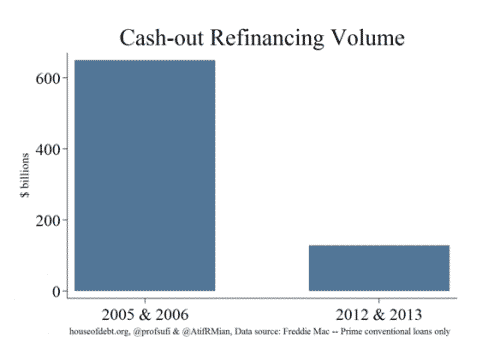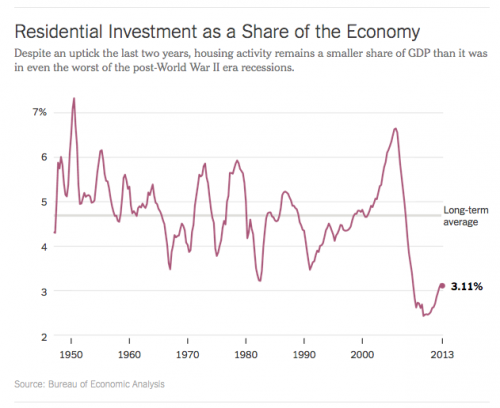Economic and market themes: 2014-04-25 US, Russia, Argentina
Topics for today:
- Tail risk from Ukraine is increasing, giving rise to investment opportunity
- Argentina is still a basket case
- US housing will not add appreciably to a US growth acceleration
I think the big news in the markets is still Ukraine. When I last wrote about the situation in Ukraine, I warned that, “It looks like we will get a military response. And as such, the potential for dramatically increasing tension with Russia is high. The European periphery will be especially vulnerable because of this. In addition, Russia is already moving away from the West as a hedge.” Indeed, we have seen a military response by Ukraine against the pro-Russian separatists or insurgents, whatever you want to call them. The Russians have begun military exercises, which the Ukrainians see as threatening. And the US is preparing deeper sanctions.
Where will this lead? We don’t know yet because it is an unstable political situation. This means that tail risk is much larger right now – and that creates opportunity, both on the long and the short side. For example, I think European sovereign bond convergence is predicated on continued recovery. Spain just showed a 0.4% increase in Q1 2014 GDP after a 0.2% rise n Q4 last year. That’s the biggest economic gain in Spain in 6 years. I have been saying Spain could grow at a faster rate than Germany this year. And, in my view, optimism associated with growth is what is driving convergence. All this is out the window if we see sanctions and a tit for tat response that includes the Russian natural gas weapon. In Spain, mortgage credit is in its 46th month of decline with year-on-year mortgage approvals down 33% in February 2014. That tells you that debt deflation is not far away. In a recessionary scenario, convergence will become divergence and crisis will resume in Europe, with a potential short opportunity developing as a result.
At the same time, Russian equities are trading at ridiculously low price multiples. Yesterday, I spoke to portfolio manager Paul Brodsky on Boom Bust about investment opportunities and he singled out two Russian companies, Sberbank and Gazprom as looking very attractive. Paul said that Gazprom, for example was trading at 2 times earnings whereas Exxon Mobil was trading at a normal 12x multiple. That presents an opportunity on the long side irrespective of sanctions. If you think back to the late 1990s, we saw the same kind of thing with the independent refiners in the US. Downstream oil was not sexy at all and the independent oil refiners were trading at single digit multiples. Valero, Premcor, Tesoro, and Sunoco were all trading with P/E multiples in the single digits, a huge discount to the energy space and the market overall, something especially notable given the technology bubble. At the same time, the sour-sweet crude differential was widening and complex refiners like the independents could take advantage by refining heavy, sour crude and making a bigger spread. Bottom line: eventually people woke up to this trade and these companies share prices went way up. But investors who got in early saw the biggest returns. The discounts in Russian equities may be a similar opportunity, according to Paul.
Now moving to another emerging market, Argentina, I am not bullish on Argentina. The numbers are totally bogus, the economic policy there is driving away foreign policy and economic growth is headed down. Yesterday, on Boom Bust we aired a show that was in part on Argentina, via a conversation with Steve Hanke. His view is that the numbers in Argentina are more doctored than you might even think, with inflation running at 75% annually. Personally, I think default is a real possibility. And the question is what impact this would have in terms of contagion. I am not sure it will have an impact. But given the other emerging market problems like Civil unrest in Brazil, rebalancing in China, civil war in Ukraine, and sanctions on Russia, we are seeing very big markets in turmoil. The emerging markets crisis is not over by a long shot.
Take a look at the Brodsky and Hanke interviews below.
Moving on to the developed economies, I want to concentrate on the US because there is a lot of housing data out recently. US existing home sales were weak at a seasonally-adjusted annualized run rate of 4.59 million. Cash buyers and distressed sales still dominate. This marks the seventh month in eight of declining sales for existing homes. And new home sales were down 14.5% month-over-month. Yet, sales prices for new homes were up 13% year-over-year. What’s going on? As far as I can tell, there are multiple factors here.
First, mortgage rates have increased since the Fed first said it was going to taper large scale asset purchases. That has cooled demand for housing. Mortgage lending was at the lowest level in 14 years in Q1 2014 as lenders originated $235 billion in loans, down 58% from the year-ago period. Now, a lot of this was weather-related. But, according to the Wall Street Journal, the decline in lending was due almost entirely to the fall in refinancing activity, which says that the rise in interest rates is having a big impact here. Second demand for housing is being further dented by the real economy and demographic shifts that have slowed new household formation. The decline in the labor participation rate is not all about low-skilled workers and skills mismatch at all. Hardly. What we are seeing is an involuntary under- and unemployment that is being felt as a slowdown in new household formation, slowing demand for housing.
Third, the student debt crisis in the US means that first-time home buyers are saddled with so much debt that they are being priced out of the market as house prices rise. The result then has been a skew toward higher priced house sales where the lower priced houses are being bid up by buy-to-let cash investors who then rent these houses out to lower-tier earners, causing rent prices to rise. On the new home front, Morgan Stanley notes that “new homes priced between $150,000 and $299,000 made up 47% of March sales, down from 57% in February, and homes priced between $300,000 and $499,000 made up 39% of March sales, up from 30% in February.” In San Francisico, the median listing price for homes is now $867,280, pricing a ton of people out of the housing market. This shows us an increase in inequality that makes the Piketty book on the subject so talked about. Finally, REOs and foreclosures, which sell at a discount, because banks have been motivated sellers and the properties are not as well maintained, are less of the market. This is putting upward pressure on prices.
The bottom line here is that housing is not going to be a huge lift to the real economy. On the one hand, higher mortgage rates means less refi activity, which also then means there is no freeing up of cash flow from refinancing mortgages and certainly no housing ATM. The blog “House of Debt” did a good analysis of this, producing the associated chart.
They also noted that the differential is understated because it only considers prime mortgages where the subprime market was a large percentage of sales in 2005 and 2006.
Looking at housing from the homebuilder front, in terms of addition to GDP through residential property activity, The New York Times highlighted the declining share of GDP that is associated with residential investment, for all of the reasons I enumerated above. This chart is a good one:
So, as we move forward, the potential US GDP growth acceleration is not going to be housing-led. It will have to be business investment and wage/job growth led. Housing will not add appreciably in any meaningful way to the lengthening of this upturn. if anything, the uptick in house prices is a bad sign, as it is underpinned by income inequality, higher rental prices and slowing mortgage and housing demand.


Comments are closed.